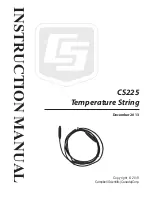
5-4
G60 Generator Protection System
GE Multilin
5.1 OVERVIEW
5 SETTINGS
5
5.1.2 INTRODUCTION TO ELEMENTS
In the design of UR relays, the term
element
is used to describe a feature that is based around a comparator. The compar-
ator is provided with an input (or set of inputs) that is tested against a programmed setting (or group of settings) to deter-
mine if the input is within the defined range that will set the output to logic 1, also referred to as
setting the flag
. A single
comparator may make multiple tests and provide multiple outputs; for example, the time overcurrent comparator sets a
pickup flag when the current input is above the setting and sets an operate flag when the input current has been at a level
above the pickup setting for the time specified by the time-current curve settings. All comparators use analog actual values
as the input.
An exception to this rule is digital elements, which use logic states as inputs.
Elements are arranged into two classes,
grouped
and
control
. Each element classed as a grouped element is provided with
six alternate sets of settings, in setting groups numbered 1 through 6. The performance of a grouped element is defined by
the setting group that is active at a given time. The performance of a control element is independent of the selected active
setting group.
The main characteristics of an element are shown on the element logic diagram. This includes the inputs, settings, fixed
logic, and the output operands generated (abbreviations used on scheme logic diagrams are defined in Appendix F).
Some settings are specified in per-unit (pu) calculated quantities:
pu quantity
= (actual quantity) / (base quantity)
Where the current source is from a single CT, the
base quantity
is the nominal secondary or primary current of the CT. Use
the secondary current base to convert per-unit current settings to/from a secondary current value, and use the primary cur-
rent base to convert to/from a primary current value.
Where the current source is the sum of two or more CTs with different nominal primary current, the primary base quantity is
the largest nominal primary current. For example, if CT1 = 300 / 5 A and CT2 = 100 / 1 A, then in order to sum these, CT2
is scaled to the CT1 ratio. In this case, the base quantity is 300 A primary, 5 A secondary for CT1, and 300/(100/1) = 3 A
secondary for CT2.
For voltage elements the primary base quantity is the nominal phase-to-phase primary voltage of the protected system pro-
vided that the VT ratio setting is set to the nominal ratio of the VTs and the secondary voltage setting is set to the phase-to-
phase voltage seen by the relay when the voltage of the protected system in nominal. The UR uses the convention that
nominal voltages in a three-phase system are phase-to-phase voltages.
For example, on a system with a 13.8 kV nominal primary voltage, the base quantity is 13800 V. With 14400:120 V delta-
connected VTs, the secondary base quantity and secondary voltage setting is:
(EQ 5.1)
DCMA OUTPUTS
SETTINGS
TESTING
TEST MODE
FUNCTION: Disabled
TEST MODE INITIATE:
On
FORCE CONTACT
INPUTS
FORCE CONTACT
OUTPUTS
PMU TEST VALUES
NOTE
13800
14400
----------------
120
×
115 V
=
Summary of Contents for Multilin g60
Page 10: ...x G60 Generator Protection System GE Multilin TABLE OF CONTENTS INDEX ...
Page 32: ...1 22 G60 Generator Protection System GE Multilin 1 5 USING THE RELAY 1 GETTING STARTED 1 ...
Page 160: ...4 30 G60 Generator Protection System GE Multilin 4 3 FACEPLATE INTERFACE 4 HUMAN INTERFACES 4 ...
Page 486: ...5 326 G60 Generator Protection System GE Multilin 5 10 TESTING 5 SETTINGS 5 ...
Page 518: ...6 32 G60 Generator Protection System GE Multilin 6 5 PRODUCT INFORMATION 6 ACTUAL VALUES 6 ...
Page 532: ...7 14 G60 Generator Protection System GE Multilin 7 2 TARGETS 7 COMMANDS AND TARGETS 7 ...
Page 748: ...D 10 G60 Generator Protection System GE Multilin D 1 IEC 60870 5 104 APPENDIX D D ...
Page 760: ...E 12 G60 Generator Protection System GE Multilin E 2 DNP POINT LISTS APPENDIX E E ...
















































